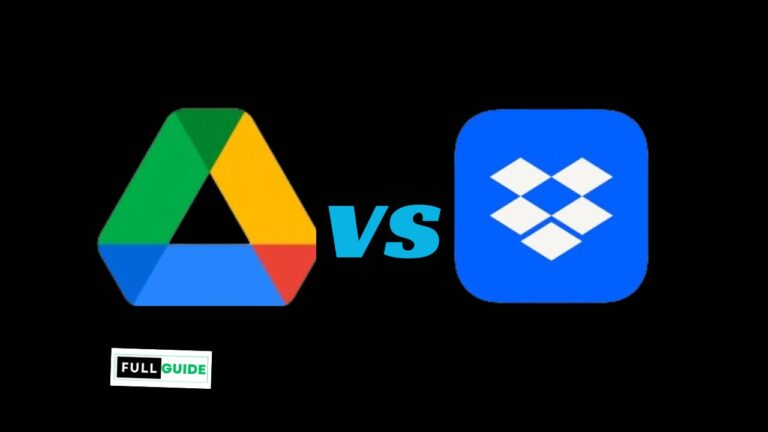Google Drive vs Dropbox : The Ultimate Comparison to Help You Choose the Best Cloud Storage
Table of Contents
Introduction
In today’s digital world, cloud storage has become a vital tool for both consumers and organizations. With the convenience of accessing and sharing files from any device with an internet connection, cloud storage options have revolutionized the way we store and manage our data. Two of the most popular cloud storage solutions are Google Drive and Dropbox. In this blog post, we will compare these two platforms to help you decide which one is the right fit for your needs. So, let’s dive into the Google Drive vs Dropbox debate and explore the features, benefits, and drawbacks of each.
Google Drive vs Dropbox Overview
Before we delve into the detailed comparison, let’s start by understanding what Google Drive and Dropbox are and how they work.
Google Drive
Google Drive is a cloud storage service offered by Google that allows users to store, share, and collaborate on files and documents. It integrates seamlessly with other Google services, such as Google Docs, Sheets, and Slides, making it a popular choice for individuals and businesses already using Google’s suite of productivity tools. With Google Drive, you can store files of various formats, including documents, images, videos, and more. It offers a user-friendly interface and provides 15 GB of free storage space per Google account.
Dropbox
Dropbox, on the other hand, is an independent cloud storage platform founded in 2007. With Dropbox, users can store and share files, as well as collaborate with others on shared folders. It offers a variety of storage plans, including a free tier with 2 GB of storage space. Dropbox also provides seamless access to files across multiple devices, making it a popular choice for both personal and professional use.
Storage and Pricing Comparison
One of the most critical factors to consider when choosing a cloud storage solution is the storage capacity and pricing options available. Let’s compare Google Drive and Dropbox in terms of these aspects.
Google Drive Storage and Pricing
Google Drive comes with 15 GB of free storage space per Google account. This storage ability is shared among Google Drive, Gmail, and Google Photos. If you require additional storage, Google offers various pricing plans:
- 100 GB storage: $1.99 per month
- 200 GB storage: $2.99 per month
- 2 TB storage: $9.99 per month
- 10 TB storage: $99.99 per month
- 20 TB storage: $199.99 per month
- 30 TB storage: $299.99 per month
Dropbox Storage and Pricing
Dropbox starts with a free tier, providing users with 2 GB of storage space. Here are the pricing plans for additional storage:
- Dropbox Plus (2 TB): $9.99 per month (or $99 per year)
- Dropbox Family (2 TB, up to 6 users): $16.99 per month (or $203.88 per year)
- Dropbox Professional (3 TB): $16.58 per month (or $199 per year)
- Dropbox Business (starting at 5 TB): Pricing varies based on the number of users and storage requirements.
While Google Drive offers more free storage, Dropbox’s paid plans generally provide more storage options.
File Sharing and Collaboration Features
Both Google Drive and Dropbox offer robust file sharing and collaboration features, but there are some differences worth noting.
Google Drive File Sharing and Collaboration
Google Drive excels in collaboration due to its integration with other Google services. It allows real-time collaboration on documents, spreadsheets, and presentations, allowing multiple users to work on the same file simultaneously. Users can leave comments, suggest edits, and track document revisions with ease. Additionally, Google Drive’s sharing settings allow users to control access levels, making it simple to share files with specific individuals or make them accessible to anyone with a link.
Dropbox File Sharing and Collaboration
Dropbox also offers file sharing and collaboration capabilities. Users can share files and folders with others, allow for commenting and editing, and view version history. However, Dropbox’s collaboration features are not as extensive as Google Drive’s. While multiple users can work on a shared file, simultaneous editing is not possible. Dropbox also lacks the integrated real-time collaboration tools offered by Google Drive.
Security and Privacy Measures
When it comes to cloud storage, security and privacy are of paramount importance. Let’s compare the security measures implemented by Google Drive and Dropbox.
Google Drive Security and Privacy
Google Drive employs advanced security measures to protect users’ data. It includes data encryption at rest and in transit, preventing unauthorized access to files. Google Drive also offers two-step verification, adding an extra layer of security to user accounts. Additionally, Google’s extensive experience in handling user data ensures rigorous security protocols and regular security audits.
Dropbox Security and Privacy
Similarly, Dropbox prioritizes user data security and privacy. It provides robust encryption measures to protect files and offers two-step verification for added account security. Dropbox also complies with various industry standards, including SOC 2 and GDPR, ensuring the protection of user data.
Accessibility and Integration
The accessibility and integration options of a cloud storage service can greatly impact its usability. Let’s explore how Google Drive and Dropbox fare in these aspects.
Google Drive Accessibility and Integration
Google Drive is accessible through any web browser and offers dedicated apps for Windows, macOS, Android, and iOS devices. This wide range of accessibility options allows users to access their files from various devices seamlessly. Moreover, Google Drive integrates smoothly with other Google services, such as Gmail, Google Calendar, and Google Photos, streamlining workflow for individuals and businesses already using these tools.
Dropbox Accessibility and Integration
Dropbox is accessible through web browsers and offers dedicated apps for Windows, macOS, Linux, Android, and iOS devices. This extensive compatibility ensures that users can access their files from virtually any platform. Dropbox also provides integration with popular applications like Microsoft Office, Slack, and Adobe Creative Cloud, enhancing productivity and collaboration.
READ MORE: Photoshop vs Affinity: Which is better between
Mobility and Syncing Capabilities
The ability to access files on the go and ensure seamless syncing is crucial for many users. Let’s compare how Google Drive and Dropbox perform in terms of mobility and file syncing.
Google Drive Mobility and Syncing
Google Drive’s mobile apps for Android and iOS devices allow users to access and manage their files with ease on the go. The files stored in Google Drive are automatically synced across all devices linked to the user’s Google account, ensuring that the latest version of each file is readily accessible.
Dropbox Mobility and Syncing
Similar to Google Drive, Dropbox offers mobile apps for Android and iOS devices, enabling users to access and sync their files on the go. Dropbox’s sync feature ensures that any changes made to files on one device are automatically reflected across all linked devices, providing a seamless and consistent user experience.
Customer Support and User Satisfaction
In times of need, reliable customer support is vital. Let’s evaluate the customer support options offered by Google Drive and Dropbox, as well as their overall user satisfaction ratings.
Google Drive Customer Support and User Satisfaction
Google provides comprehensive online documentation and a user support forum to assist Google Drive users. Additionally, users with paid Google Drive storage plans can access 24/7 customer support via phone, chat, or email. Google Drive has generally positive user satisfaction ratings, with users appreciating its user-friendly interface, collaborative features, and integration with other Google services.
Dropbox Customer Support and User Satisfaction
Dropbox offers customer support through an online help center, as well as phone and email support for paying customers. Dropbox also provides a user support forum where users can seek assistance, connect with other users, and share tips and tricks. User satisfaction with Dropbox is generally high, with many praising its simplicity, ease of use, and reliable file syncing capabilities.
Final Verdict
After analyzing various aspects of Google Drive and Dropbox, it’s clear that both platforms offer robust cloud storage solutions. Here’s a quick summary:
- If you heavily rely on Google’s productivity tools and prefer seamless integration with other Google services, Google Drive may be the ideal choice for you.
- If simplicity, ease of use, and reliable file syncing are your main priorities, Dropbox may be a better fit.
Consider factors such as storage capacity, pricing, collaboration features, security measures, accessibility, integration options, and mobility when making your final decision.
Conclusion
In conclusion, choosing between Google Drive and Dropbox requires careful consideration of various factors. By evaluating their storage and pricing, file sharing and collaboration features, security and privacy measures, accessibility and integration options, mobility and syncing capabilities, customer support, and user satisfaction, you can make an informed decision. Remember to prioritize your specific needs and preferences when selecting the right cloud storage solution for you. Whichever option you choose, both Google Drive and Dropbox offer powerful tools to enhance your productivity and streamline your data storage and sharing workflows.
Google Drive vs Dropbox Google Drive vs Dropbox Google Drive vs Dropbox Google Drive vs Dropbox Google Drive vs Dropbox Google Drive vs Dropbox Google Drive vs Dropbox Google Drive vs Dropbox Google Drive vs Dropbox Google Drive vs Dropbox Google Drive vs Dropbox Google Drive vs Dropbox Google Drive vs Dropbox Google Drive vs Dropbox Google Drive vs Dropbox Google Drive vs Dropbox








